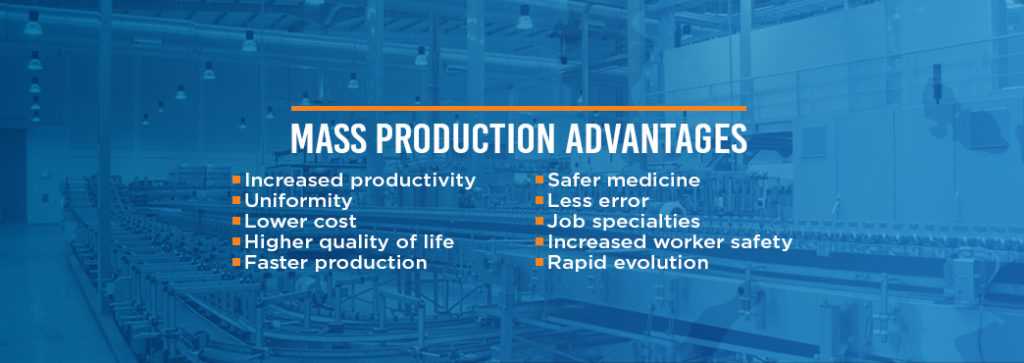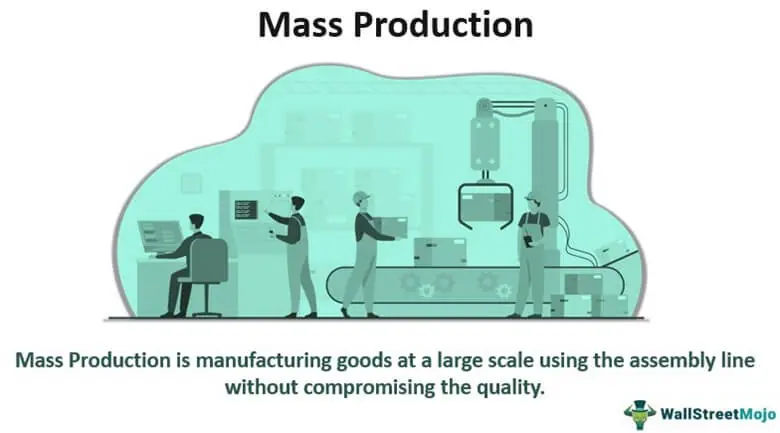Mass Production: Examples, Advantages, Disadvantages
Examples of Mass Production

There are numerous examples of mass production in various industries. One of the most well-known examples is the production of automobiles. Car manufacturers use assembly lines to produce large numbers of cars with standardized parts and processes. This allows them to achieve economies of scale and lower production costs.
Another example is the production of electronic devices such as smartphones and computers. Companies like Apple and Samsung use mass production techniques to produce millions of devices that are virtually identical. This enables them to meet the high demand for their products and keep prices competitive.
Advantages of Mass Production
Mass production offers several advantages for manufacturers. Firstly, it allows for increased efficiency and productivity. By using specialized machinery and standardized processes, manufacturers can produce goods at a faster rate and with fewer errors.
Secondly, mass production enables cost savings through economies of scale. When producing large quantities of a product, manufacturers can negotiate better deals with suppliers, reduce material costs, and optimize their production processes. This results in lower per-unit costs and increased profitability.
Furthermore, mass production facilitates consistent product quality. With standardized processes and quality control measures in place, manufacturers can ensure that each product meets the same specifications. This helps build customer trust and loyalty.
Disadvantages of Mass Production

Despite its advantages, mass production also has some disadvantages. One of the main drawbacks is the lack of flexibility. Mass production relies on producing large quantities of identical products, which can be problematic if there is a sudden change in market demand or if customization is required.
Another disadvantage is the initial investment required for setting up mass production facilities. Specialized machinery, assembly lines, and automation systems can be costly to implement. This can pose a barrier to entry for smaller manufacturers or startups.
Additionally, mass production can lead to environmental concerns. The production of large quantities of goods often requires significant amounts of energy and resources. This can contribute to pollution and waste generation if not managed properly.
Examples of Mass Production
Mass production is a manufacturing process that involves the production of large quantities of identical products. This method of production has been widely adopted in various industries, including automotive, electronics, and consumer goods. Here are some examples of mass production:
1. Automobile Industry: The automobile industry is one of the prime examples of mass production. Companies like Ford, Toyota, and General Motors use assembly lines to produce thousands of cars every day. This allows them to achieve economies of scale and offer affordable vehicles to consumers.
2. Electronics Industry: The electronics industry heavily relies on mass production to meet the high demand for electronic devices. Companies like Apple, Samsung, and Sony produce millions of smartphones, tablets, and other electronic gadgets using automated production lines. This enables them to keep up with the rapidly changing technology and offer competitive prices to customers.
3. Fast Food Industry: The fast food industry is another example of mass production. Fast food chains like McDonald’s and Burger King use standardized recipes and production methods to produce large quantities of food quickly. This allows them to serve a large number of customers efficiently and maintain consistent quality across their outlets.
4. Clothing Industry: The clothing industry relies on mass production to produce garments in large quantities. Companies like H&M, Zara, and Nike use automated sewing machines and assembly lines to produce clothes at a fast pace. This enables them to offer a wide range of affordable clothing options to consumers.
5. Consumer Goods Industry: The consumer goods industry, which includes products like household appliances, furniture, and personal care items, also utilizes mass production. Companies like Procter & Gamble, Samsung, and Whirlpool produce large quantities of these goods using automated production processes. This allows them to meet the demand of consumers and offer competitive prices in the market.
Overall, mass production plays a crucial role in various industries by enabling the production of large quantities of products efficiently and cost-effectively. It has revolutionized the manufacturing sector and has contributed to the availability of affordable products for consumers worldwide.
Advantages of Mass Production
Mass production is a manufacturing process that involves the production of a large number of identical products. This method of production offers several advantages, which have contributed to its widespread use in various industries.
1. Cost Efficiency
2. Consistency and Quality Control
Mass production allows for consistent production of identical products. This ensures that each item meets the same quality standards, as any defects or errors can be identified and corrected quickly. Quality control measures can be implemented throughout the production process to ensure that the final products meet the required specifications.
3. Faster Production Time
Mass production enables faster production times compared to other manufacturing methods. The use of assembly lines and automated machinery allows for a continuous flow of production, reducing the time required to produce each unit. This increased speed can help meet high consumer demand and reduce lead times.
4. Lower Prices for Consumers
Due to the cost efficiency of mass production, manufacturers can offer products at lower prices to consumers. The reduced production costs allow for competitive pricing, making products more affordable and accessible to a larger market. This can lead to increased sales and market share for manufacturers.
5. Innovation and Standardization
Mass production encourages innovation and standardization. Manufacturers can invest in research and development to improve production processes and introduce new technologies. Standardization of components and processes also allows for interchangeability and compatibility, making it easier to repair and replace parts.
| Advantages of Mass Production |
|---|
| Cost Efficiency |
| Consistency and Quality Control |
| Faster Production Time |
| Lower Prices for Consumers |
| Innovation and Standardization |
Disadvantages of Mass Production
While mass production has numerous advantages, it also comes with its fair share of disadvantages. These disadvantages include:
1. Lack of customization: Mass production is focused on producing large quantities of standardized products. This means that customization options are limited, and consumers may not be able to get products that meet their specific needs or preferences.
2. High initial investment: Setting up a mass production system requires a significant initial investment in machinery, equipment, and infrastructure. This can be a barrier for small businesses or startups that may not have the financial resources to make such investments.
3. Lack of flexibility: Mass production is designed for efficiency and high volume production. As a result, it can be challenging to make changes to the production process or introduce new products quickly. This lack of flexibility can be a disadvantage in industries where consumer preferences and market trends change rapidly.
4. Quality control issues: With mass production, there is a higher risk of quality control issues. When producing large quantities of products, it becomes more difficult to ensure that each item meets the required quality standards. This can lead to customer dissatisfaction and damage to the company’s reputation.
5. Environmental impact: Mass production often involves the use of large amounts of resources, energy, and raw materials. This can have a significant environmental impact, including pollution, depletion of natural resources, and increased carbon emissions. As sustainability becomes increasingly important, the environmental impact of mass production is a significant disadvantage.
6. Job displacement: The automation and efficiency of mass production can lead to job displacement. As machines and technology take over repetitive tasks, there may be a decrease in the number of jobs available for manual laborers. This can have negative social and economic consequences for communities that rely on manufacturing industries.
The Role of Mass Production in Economics
Mass production plays a crucial role in the field of economics. It is a manufacturing process that involves the production of goods in large quantities, usually using assembly lines and specialized machinery. This method of production has revolutionized various industries and has had a profound impact on the global economy.
Efficiency: One of the key advantages of mass production is its ability to produce goods at a much faster rate compared to traditional methods. By using standardized processes and specialized machinery, manufacturers can achieve higher levels of efficiency and productivity. This leads to lower production costs and allows companies to offer products at more competitive prices.
Job Creation: Mass production has also played a significant role in job creation. While it may have initially led to job losses in certain industries, it has also created new employment opportunities in manufacturing and related sectors. The demand for skilled workers to operate and maintain the specialized machinery used in mass production has increased, leading to the creation of new jobs and the growth of the workforce.
Standardization: Mass production relies on standardized processes and components, which ensures consistency and quality in the final products. This allows companies to establish a strong brand reputation and build customer trust. Standardization also facilitates easier maintenance and repair of products, as replacement parts are readily available and interchangeable.
Environmental Impact: While mass production has numerous advantages, it also has some disadvantages, particularly in terms of its environmental impact. The large-scale production of goods often leads to increased resource consumption and waste generation. However, many companies are now implementing sustainable practices and technologies to mitigate these negative effects and reduce their carbon footprint.

Emily Bibb simplifies finance through bestselling books and articles, bridging complex concepts for everyday understanding. Engaging audiences via social media, she shares insights for financial success. Active in seminars and philanthropy, Bibb aims to create a more financially informed society, driven by her passion for empowering others.
